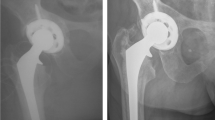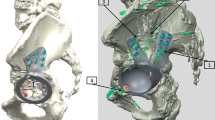Abstract
Between 1988 and 2002, 47 patients (50 hips) were treated with acetabular shell augmentation arthroplasty for recurrent idiopathic dislocation of their total hip arthroplasty. Apparent causes for dislocation such as deep infection, component malposition, or polyethylene wear were excluded. Follow-up averaged 74 months (range, 12–178 months), and clinically, 30 hips (60%) did not present a subsequent dislocation at most recent follow-up. In five hips (10%), deep infection after the augmentation procedure necessitated removal of the entire prosthesis. In our opinion, this technique cannot be recommended as it has an unacceptable failure and high infection rate.
Résumé
Entre 1988 et 2002, 47 patients (50 hanches) ont été traités avec un secteur additionnel pour luxation récidivante de la PTH. Les causes apparentes de luxations avec infection profonde, malposition du composant et usure du polyéthylène ont été exclues de cette étude. Le suivi moyen a été de 74 mois (de 12 à 178 mois), 60% des hanches (30 hanches) ne présentent pas de récidive de la luxation au dernier suivi. Dans 5 hanches (10%), une infection profonde est survenue, nécessitant l’ablation de la prothèse. Pour nous cette technique ne peut être recommandée car elle présente un taux d’échecs inacceptable et un taux d’infection important.



Similar content being viewed by others

References
Bradbury N, Milligan GF (1994) Acetabular augmentation for dislocation of the prosthetic hip. A 3 (1–6)-year follow-up of 16 patients. Acta Orthop Scand 65:424–426
Charlwood AP, Thompson NW, Thompson NS, Beverland DE, Nixon JR (2002) Recurrent hip arthroplasty dislocation. Good outcome after cup augmentation in 20 patients followed for 2 years. Acta Orthop Scand 73:502–505
Clayton ML, Thirupathi RG (1983) Dislocation following total hip arthroplasty. Management by special brace in selected patients. Clin Orthop 154–159
Cohen B, Field RE, Muirhead-Allwood WFC, Rushton N, Scott JE (1994) Problems seen after Olerud acetabular augmentation for recurrent dislocation of total hip arthoplasty. Hip Int 4:80–84
Dorr LD, Wolf AW, Chandler R, Conaty JP (1983) Classification and treatment of dislocations of total hip arthroplasty. Clin Orthop 151–158
Gie A, Scott TD, Ling RSM (1989) Cup augmentation for recurrent hip replacement dislocation. J Bone Joint Surg [Br] 71:338
Graham G P, Jenkins A I R, Mintowt-Cycz W (1988) Recurrent dislocation following hip replacements. J Bone Joint Surg [Br] 70:675
Güngör T, Hallin G (1990) Cup re-enforcement for recurrent dislocation after hip replacement. J Bone Joint Surg [Br] 72:525
Lewinnek GE, Lewis JL, Tarr R, Compere CL, Zimmerman JR (1978) Dislocations after total hip-replacement arthroplasties. J Bone Joint Surg Am 60:217–220
Mogensen B, Arnason H, Jonsson GT (1986) Socket wall addition for dislocating total hip. Acta Orthop Scand 57:373
Nicholl JE, Koka SR, Bintcliffe IW, Addison AK (1999) Acetabular augmentation for the treatment of unstable total hip arthroplasties. Ann R Coll Surg Engl 81:127–132
Olerud S, Karlström G (1985) Recurrent dislocation after total hip replacement. Treatment by fixing an additional sector to the acetabular component. J Bone Joint Surg [Br] 67:402–405
Reickerås O (1988) Acetabular arthroplasty to prevent dislocation after total hip replacement. Acta Othop Scand Suppl 60:231
Stewart HD (1983) The hip cast-brace for hip prosthesis instability. Ann R Coll Surg Engl 65:404–406
Watson P, Nixon JR, Mollan RA (1991) A prosthesis augmentation device for the prevention of recurrent hip dislocation. A preliminary report. Clin Orthop 79–84
Widmer KH (2004) A simplified method to determine acetabular cup anteversion from plain radiographs. J Arthroplasty 19:387–390
Williams JF, Gottesman MJ, Mallory TH (1982) Dislocation after total hip arthroplasty. Treatment with an above-knee hip spica cast. Clin Orthop:53–58
Williamson JB, Galasko CS, Rowley DI (1989) Failure of acetabular augmentation for recurrent dislocation after hip arthroplasty. Report of 3 cases. Acta Orthop Scand 60:676–677
Author information
Authors and Affiliations
Corresponding author
Additional information
No benefits or funds were received in support of this study.
Rights and permissions
About this article
Cite this article
Bosker, B.H., Ettema, H.B., Verheyen, C.C.P.M. et al. Acetabular augmentation ring for recurrent dislocation of total hip arthroplasty: 60% stability rate after an average follow-up of 74 months. International Orthopaedics (SICO 33, 49–52 (2009). https://doi.org/10.1007/s00264-007-0456-0
Received:
Revised:
Accepted:
Published:
Issue Date:
DOI: https://doi.org/10.1007/s00264-007-0456-0



